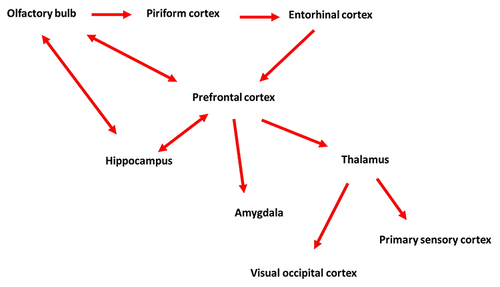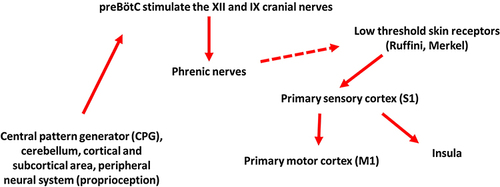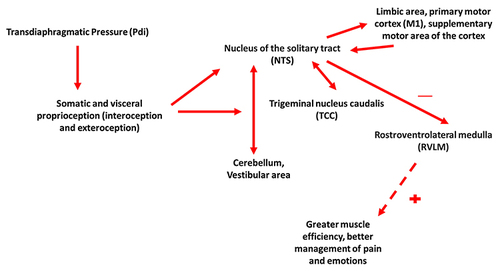Figures & data
Figure 1 Pre-inspiratory discharge: passing by the nose. The schematic image highlights the first relationships during the pre-inhale phase. Air enters the nose and stimulates (via the olfactory nerve) the olfactory bulb. The afferent flows to the piriform cortex and then to the entorhinal cortex. From the entorhinal cortex afferents will be sent to the prefrontal cortex, which will send information to the thalamus and the amygdala, the hippocampus. The hippocampus, the olfactory bulb and the prefrontal cortex are always in one-to-one communication. The thalamus will send information to the primary sensory cortex and the visual occipital cortex. The nervous system, through the pre-inspiration, prepares the person for action (cognitive and motor), with respect to the need and the external environment.

Figure 2 Initial contraction of the diaphragm on inspiration. The figure schematises the systemic information that the central pattern generator (CPG) receives, from which the efference for the contraction of the diaphragm will derive. The very first muscle contraction stimulates cutaneous receptors (dashed arrow) which will send information to the area of the primary sensory cortex (S1). S1 will stimulate the insula and primary motor cortex (M1). In this phase, the body prepares to better manage all the proprioceptive information that will arrive from the complete contraction of the diaphragm.

Figure 3 The completion of the diaphragmatic contraction. The inspiration generates an intra-abdominal pressure (IAP), which stimulates the proprioceptive receptors (the sum of the interoceptive and exteroceptive receptors). The afferents will travel towards the nucleus of the solitary tract (NTS) for 95%, while the remaining information will go towards the trigeminal nucleus caudalis (TCC); NTS and TCC can exchange information with each other. NTS will exchange information with the cerebellum and vestibular area. Once all the proprioceptive information processed by the continuous exchanges has been collected, NTS will send the afferents towards the limbic area, the primary (M1) and supplementary motor cortex. Reprocessed the information, these last areas will send new efferents towards NTS, which will download further (inhibitory) efferents towards the rostroventrolateral medulla area (RVLM), slowing down the sympathetic activity. The result (dashed line) will be a better efficiency of neuromuscular expression, and a better management of pain and emotions.

